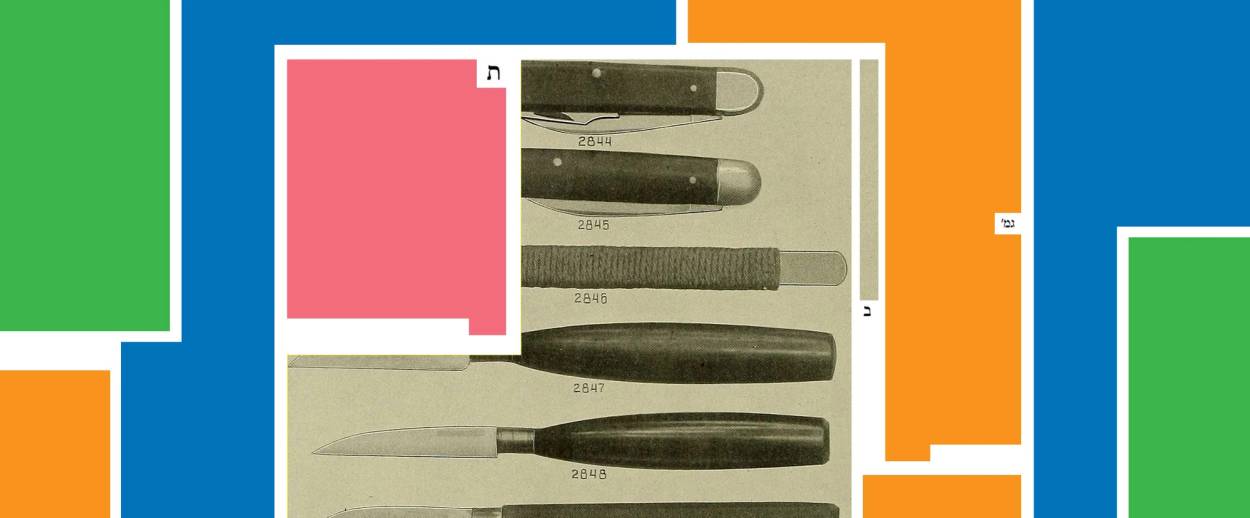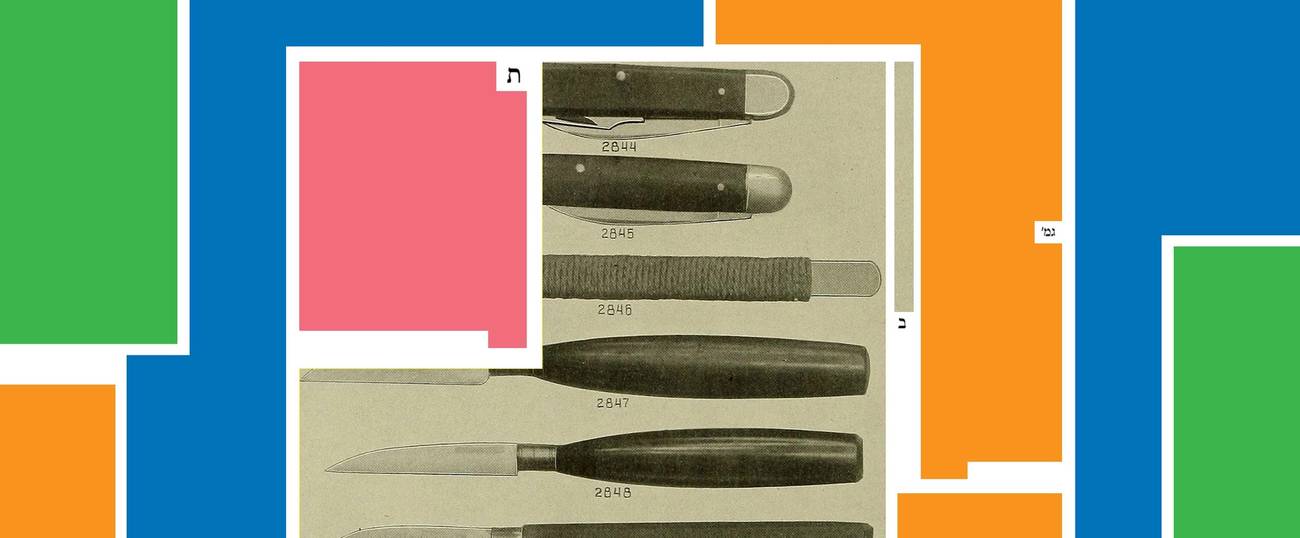Cuts Like a Knife
In this week’s ‘Daf Yomi,’ the Talmud reiterates how intention defines human acts. Plus: Does a dropped blade accidentally decapitating an animal count as ritual slaughter?




Literary critic Adam Kirsch is reading a page of Talmud a day, along with Jews around the world.
As Daf Yomi readers continued to study Tractate Hullin over the last several weeks, we saw the rabbis grapple with a number of questions related to the rules of kosher slaughter. The basic procedure for slaughtering animals and birds is simple to learn, though it requires skill and practice to carry out. The slaughterer must use a sharp-edged instrument to sever the windpipe and gullet of the animal—the two tubes that the Talmud calls simanim—using a back-and-forth cutting motion. He must take care not to tear or puncture the simanim, or conceal the knife in the animal’s flesh in such a way that the cutting of the simanim can’t be observed. Beyond that, the Talmud allows considerable leeway in slaughtering: Any Jew can perform the act, using any kind of instrument, at any time of day. Unlike sacrificial slaughter in the Temple, which is a restricted and carefully choreographed ritual, slaughter for the purpose of eating is part of everyday life.
But of course, the rabbis wouldn’t be the rabbis if they didn’t zero in on potential problems that may arise during slaughter, and try to gain clarity about the fundamental concepts. For instance, at the beginning of Chapter 2, they raise a question so basic one might not even think it needs to be asked. Why is it that an animal must be killed by cutting its throat? Why can’t you cut some other part of its body and let it bleed to death? One might expect the answer to have to do with sparing the animal unnecessary suffering: Cutting the throat allows a quicker death than cutting elsewhere on the body.
But while this may be implicit in the logic of Jewish slaughter, it is not the reason the rabbis give. Rather, Rav Kahana finds a verbal explanation in a verse from Leviticus: The Hebrew word for slaughter (shechita) resembles the word for bends (shach), suggesting that the animal must be slaughtered at a place where its body bends. But this is hardly an iron-clad solution, as the Gemara points out: After all, the tail of an animal also bends, so why don’t we slaughter animals by severing their tails, or for that matter their ears?
The logical answer is that this would not be a reliable way of killing. As the Gemara puts it, slaughter must spill “blood of the soul,” the blood that sustains the animal’s life. Finally, the rabbis give up their search for a biblical basis for this rule, and simply attribute it to “tradition”—that is, it was one of the laws God told Moses on Sinai.
If cutting the animal’s throat is the goal, could one slaughter an animal by decapitating it—severing the head with one stroke? This is, after all, the quickest way to sever the simanim. But the mishna in Hullin 30b says no: The proper way to slaughter is to draw a knife back and forth across the throat, not to cut the whole neck through at a blow. However, if the slaughterer starts out cutting the throat in the proper way, but in the process he ends up severing the head, his slaughter is valid.
Another hypothetical problem raises the issue of whether intention matters in slaughter. “If a knife fell and slaughtered an animal, although the knife slaughtered it in the standard manner, the slaughter is not valid,” says the mishna in Hullin 31a. Even if the blade fell in exactly the right way to cut the simanim properly, it wouldn’t count as slaughter, because it lacks the crucial element of human volition. The mishna cites Deuteronomy, which says, “you shall slaughter and you shall eat”: In other words, the rabbis explain, “that which you slaughter you may eat.”
But the Gemara raises a further question. Say that the knife didn’t simply fall on its own, but it was dropped by a human being and ended up killing an animal. In this example, the man didn’t intend to perform a slaughter, but he did intend to make the knife fall. Is this enough intent to render the slaughter valid? Rabbi Oshaya puts the issue another way: “If one threw a knife to embed it in the wall and in the course of flight the knife went and slaughtered an animal in its proper manner,” is the slaughter valid or not?
Of course, this is one of those Talmudic examples that would never actually occur in real life. The point is not to solve a pragmatic dilemma, but to perform a thought experiment with the concept of intention. Does intending an action entail intending its consequences, or is the intention to perform the action itself sufficient? The Gemara cites contrasting opinions, but in the end the halacha is that slaughter by a thrown or dropped knife is valid. A slaughterer apparently does not have to intend to perform a slaughter, he only has to intend to move the blade.
The rabbis go on to consider other variations on the act of slaughter. Does it have to be performed by a single person, or can two people slaughter an animal together? The mishna in Hullin 30b permits cooperative slaughter: Either two people can grasp the same knife, or they can cut at different places on the animal’s neck with different knives. What about taking a break in the middle of a slaughter—for instance, to readjust your clothes, or to pick up a knife that fell, or if you simply “grow weary”? Here everything depends on the length of the interruption: You cannot interrupt a slaughter for an interval equivalent to the time it takes to complete another act of slaughter. In other words, you can’t start killing one animal, stop in the middle to dispatch a second animal, and then come back to the first one.
As for cutting the simanim, do they have to be completely severed, or is it sufficient to cut them most of the way through? According to the mishna in Hullin 27a, cutting a majority of each siman is sufficient: “The halachic status of the majority of one siman is like that of the entire siman.” For a large animal like a cow or sheep, the majority of both simanim—the windpipe and the gullet—must be cut, while for a bird, it’s sufficient to cut the majority of just one tube.
In figuring out the reason for this difference, the rabbis engage in some speculation about the relationship between different animal species. A verse from Leviticus reads, “This is the law of the animal, and of the bird, and of every living creature that moves in the waters,” and the rabbis see this ordering as significant: Birds are in some sense halfway between land animals and fish. To slaughter an animal requires cutting two simanim; fish, on the other hand, don’t require slaughter at all, since they have no simanim. Since birds are intermediate between animals and fish, it stands to reason that they need only one siman cut.
Rabbi Yochanan ben Zakkai agrees, adding an interpretation from the creation story in Genesis: God created animals out of earth and fish out of water, but he created birds out of mud, which is a mixture of earth and water. And Rav Shmuel of Cappadocia contributes an empirical observation: Birds “have scales on their feet like fish,” suggesting that they are part fish, part animal. In this way, the rabbis created their own theory about the origin of species.
***
Adam Kirsch embarked on the Daf Yomi cycle of daily Talmud study in August 2012. To catch up on the complete archive, click here.
Adam Kirsch is a poet and literary critic, whose books include The People and the Books: 18 Classics of Jewish Literature.